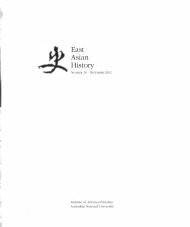Portrait of a Tokugawa Outcaste Community ... - East Asian History
Portrait of a Tokugawa Outcaste Community ... - East Asian History
Portrait of a Tokugawa Outcaste Community ... - East Asian History
You also want an ePaper? Increase the reach of your titles
YUMPU automatically turns print PDFs into web optimized ePapers that Google loves.
94TIMOTHY D. AMOS34 SDKK, ed., Suzuki-ke mania, Vol.3, 600[164].35 Ibid., VoU, 1 [2799].36 See Ooms's fascinating description <strong>of</strong>the Lower Wana village resident's participationin this execution in Ooms, TakugawaVillage Practice: Class, Status, Pawer, Law,pp.249-52.37 SDKK, ed., Suzuki-ke mania, VoU, 141[1281], 147 [121], 149 [2710]by the Matsuyama hinin leader Bangoro. Jin'emon's refusal to assume theguard duties appears to have been linked to an understanding <strong>of</strong> jurisdictionwhich related to the place in which a particular crime had beenperpetrated. 34There was, therefore, a clear shift in emphasis away from tanning andbegging to poliCing and execution functions <strong>of</strong> eta and hinin during theearly eighteenth century. The establishment <strong>of</strong> the hinin hut in LowerWana in 1710, followed by a 1724 circular in which eta and hinin <strong>of</strong> LowerWana village were ordered to perform duties related to handling prisonersfor most <strong>of</strong> the major shogunate <strong>of</strong>fices in Edo, probably signalled thebeginnings <strong>of</strong> this shift. 35 It is uncertain as to whether this was the firsttime the residents <strong>of</strong> Lower Wana village were ordered to perform suchtasks, but it is clear that it was not the last. Members <strong>of</strong> Lower Wana villagethroughout the eighteenth and nineteenth centuries were thereafter regularlymobilized to assist in the escorting <strong>of</strong> prisoners. Part <strong>of</strong> these dutiesinvolved participating in guard duties related to, or the actual carrying out<strong>of</strong>, executions. Members <strong>of</strong> Lower Wana probably began to participate innumerous public executions during the first half <strong>of</strong> the eighteenth century.The earliest extant record relates to the capital punishment <strong>of</strong> a criminalnamed Shohe /j\wj in 1743 for stealing. 36 Other notable examples arethe crucifixions <strong>of</strong> the homeless murderer Yukichi "E in 1816 and thelocal farmer Miyakichi '§"E during the Tenmei xEJ.l§ famine in 1835. 31But as the previous two examples further demonstrate, <strong>of</strong>ficial duties alsocame to involve the guarding <strong>of</strong> prisoners charged with the perpetration<strong>of</strong> certain crimes.Inter-<strong>Community</strong> Relations38 Minegishi, Kinsei hisabetsuminshi nakenkyu, p.82. SKM, #1388.3 9 One <strong>of</strong> the most interesting examples<strong>of</strong> extensive community interaction can befound in Nishiki K6ichi's account <strong>of</strong> a largefestival hosted by Lower Wana village inthe early nineteenth century. "Bushu shimowana no sairei k6gy6," in Buraku naseikatsushi, ed. Buraku mondai kenkyujo(Kyoto: Buraku mondai kenkyujo, 1988),pp.l24--28.40 SDKK, ed., Suzuki-ke mania, Vol.l,149 [2104]Any notion that eta only mixed with eta, or hinin with hinin, wouldclearly be a misconception. Deep interpersonal relationships existedbetween members <strong>of</strong> Upper and Lower Wana villages, as illustrated inMinegishi Kentaro's example <strong>of</strong> the participation <strong>of</strong> farmers in the marriageceremony <strong>of</strong> Jin'emon's second son. 3 8 In fact, the Suzuki householddocuments are replete with examples <strong>of</strong> inter-village relations with localpeasant and town communities. 39 A local pawnbroking family from anearby peasant village that lent ten bags <strong>of</strong> rice to the Suzuki householdto assist with financial expenses related to execution duties during theTempo x{* famine (arguably the period with some <strong>of</strong> the strictest legislationon outcaste activity) is another striking example confirming that thiswas the norm. 40Interestingly, however, the investment <strong>of</strong> a social disciplinary authorityin rural eta and hinin communities ultimately caused friction within thewider community. The aforementioned 1743 execution involving thepunishment <strong>of</strong> Shohe, first introduced in Anglophone scholarship in
















